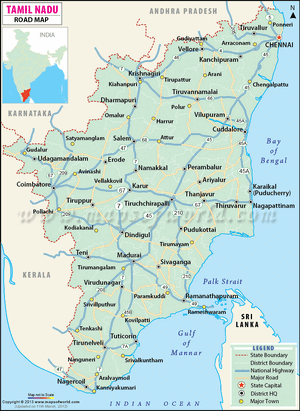Tirunelveli
| Author:Laxman Burdak, IFS (R) |

Tirunelveli (तिरुनेलवेली), also known as Nellai and historically (during British rule) as Tinnevelly, is a city and district in the Indian state of Tamil Nadu. It is the sixth-largest municipal corporation in the state after Chennai, Coimbatore, Madurai, Trichy and Salem.
Variants
- Tirunelaveli तिरुनेलवेली (मद्रास) (AS, p.401)
- Nellai
- Tinnevelly
- Tinnelvelly
Location
Tirunelveli is located 700 km southwest of the state capital Chennai, 58 km away from Thoothukudi and 73Km from Kanyakumari. The downtown is located on the west bank of the Thamirabarani River; its twin Palayankottai is on the east bank. Palayamkottai is called as the Oxford of the south India.
Etymology
Tirunelveli region is believed to have been covered with Venu forest and hence called Venuvanam.[1] Tirunelveli was known in Sambandar's seventh-century Saiva canonical work Tevaram as Thirunelveli.[2] Swami Nellaiappar temple inscriptions indicate that Shiva (as Vrihivritesvara) descended in the form of a hedge and roof to save the paddy crop of a devotee. In Hindu legend, the place was known as Venuvana ("forest of bamboo") due to the presence of bamboo in the temple under which the deity is believed to have appeared.[3] The early Pandyas named the city Thenpandya Nadu or Thenpandya Seemai, the Cholas Mudikonda Cholamandalam and the Nayaks Tirunelveli Seemai; it was known as Tinnelvelly by the British, and Tirunelveli after independence.[4][5]
The word Tirunelveli is derived from three Tamil words: thiru, nel and veli, meaning "sacred paddy hedge".[6][7]
History
Tirunelveli is an ancient city, and is more than 2000 years old. It is a hub of many schools, colleges and many important government offices. Tirunelveli is believed to be an ancient settlement of great importance. It has been ruled at different times by the Early Pandyas, the Medieval and Later Cholas, the later Pandyas, the Ma'bar , the Vijayanagar Empire, the Madurai Nayaks, Chanda Sahib, the Carnatic kingdom and the British. The Polygar War, involving Palaiyakkarars led by Veerapandiya Kattabomman and forces of the British East India Company, was waged on the city's outskirts from 1797 to 1801. Tirunelveli has a number of historical monuments, the Swami Nellaiappar Temple being the most prominent.
Nagavanshi History
Dr Naval Viyogi[8] writes.... Usually the cobra is carved in relief on a stone slab some four feet in height. But at Adichanallur[9] (a well known large centre of Magaliths) in the Tinnevelly district, there is a large group of Nagakals which shows the peculiarity that they are carved in the round. The snakes are either single-hooded or many-hooded and several of the later have a little human figure seated on the coils and overshaded by the serpents' hood.
तिरूनेलवेली परिचय
तिरूनेलवेली (Tirunelveli): चेन्नई से 465 किमी दूर स्थित (Tirunelveli) भारत के तमिल नाडु राज्य के तिरूनेलवेली ज़िले में स्थित एक नगर है। यह उस ज़िले का मुख्यालय भी है।
तिरुनेलवेली (मद्रास)
विजयेन्द्र कुमार माथुर[10] ने लेख किया है ...तिरुनेलवेली (मद्रास) (AS, p.401) बालीश्वर या कृष्णपुर के मंदिर के कारण यह स्थान प्रसिद्ध है. मंदिर में कामदेव की पत्नी रति की मानव आकार मूर्ति के रूप में श्रांगारिक भावों का सुकुमार चित्रण है. मंदिर के प्रांगण की भित्ति के नीचे एक छोटी सरिता बहती है.
External links
References
- ↑ Reddy, G.Venkatramana (2013). Alayam - The Hindu temple - An epitome of Hindu Culture. Mylapore, Chennai: Sri Ramakrishna Math. ISBN 978-81-7823-542-4. p.10
- ↑ "Moondram Thirumurai". Thevaram.org.
- ↑ Ayyar, P. V. Jagadisa (1991). South Indian shrines: illustrated. New Delhi: Asian Educational Services. ISBN 81-206-0151-3. pp. 498–499.
- ↑ Kanmony, Jebagnanam Cyril (2010). Human rights violation. ISBN 81-8324-347-9.p.42
- ↑ Caldwell, Robert (1989) [1881]. The History of Tinnevelly From The Earliest Period to the Cession to the English Government in 1801 (Reprinted ed.). Asian Educational Services. ISBN 81-206-0161-0. p.88
- ↑ P., Kannappan (2008). Scheduled Caste Welfare. New Delhi: A P H Publishing Corporation. ISBN 978-81-313-0370-2.p.67
- ↑ Caldwell, Robert (1989) [1881]. The History of Tinnevelly From The Earliest Period to the Cession to the English Government in 1801 (Reprinted ed.). Asian Educational Services. ISBN 81-206-0161-0. p.88
- ↑ Nagas, The Ancient Rulers of India, Their Origins and History, 2002, p. 31
- ↑ Vogel JPH P-271
- ↑ Aitihasik Sthanavali by Vijayendra Kumar Mathur, p.401

